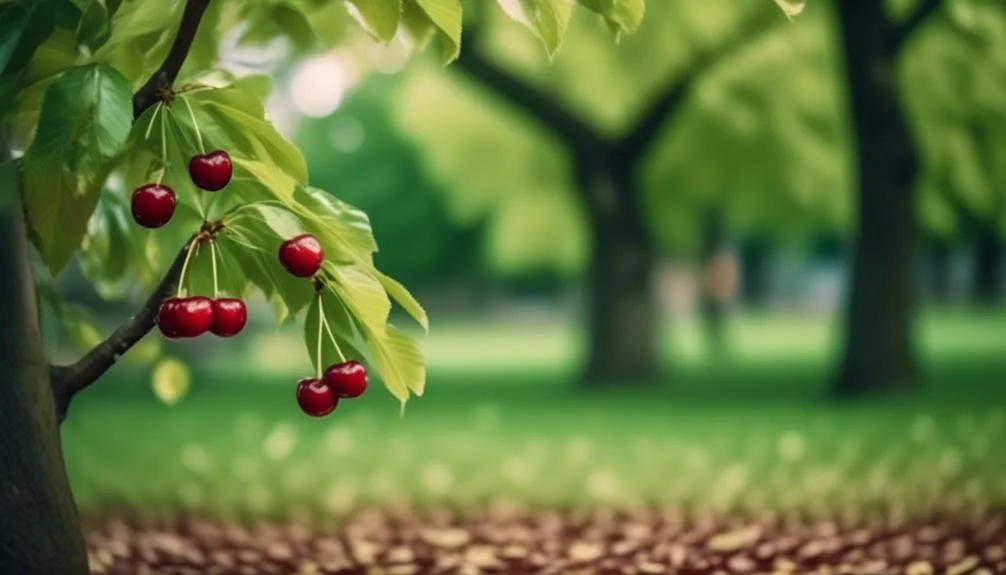Wondering why your cherry tree sheds leaves like confetti? It's common to question if this is normal or a cause for concern. Understanding the reasons behind leaf drop is crucial for your tree's well-being.
We'll discuss the signs of normal leaf shedding, reasons for abnormal leaf drop, and effective management strategies. Stick around to learn how to keep your cherry tree thriving.
Signs of Normal Leaf Drop
You may occasionally notice a few leaves dropping from your cherry tree throughout the growing season, which is a normal part of the tree's natural cycle. Seasonal changes trigger the cherry tree to shed older leaves and grow new ones. This process is vital for the tree's health and overall growth.
However, if you observe excessive leaf drop or notice leaves turning yellow or brown before falling off, it could be a sign of a nutrient deficiency. Nutrient deficiency can disrupt the normal leaf drop pattern and indicate underlying issues within the tree.
It's essential to monitor the frequency and pattern of leaf drop to determine if the tree is experiencing normal seasonal changes or if there's an underlying problem that needs to be addressed.
Causes of Abnormal Leaf Drop
Excessive leaf drop on cherry trees can be attributed to various environmental stressors or underlying health issues, impacting the tree's vitality and overall well-being. Abiotic stress, such as extreme temperatures, drought, or nutrient deficiencies, can trigger abnormal leaf shedding. Improper watering, either overwatering or underwatering, is a common cause of stress for cherry trees, leading to leaf drop and compromising the tree's ability to thrive.
| Causes of Abnormal Leaf Drop |
|---|
| Abiotic Stress |
| Improper Watering |
Understanding these potential causes can help you identify and address issues promptly, ensuring the health and vibrancy of your cherry tree. Proper care and attention to environmental factors are crucial in minimizing abnormal leaf drop and promoting the long-term well-being of your cherry tree.
Environmental Factors
After addressing the potential causes of abnormal leaf drop, it's important to consider the influence of environmental factors on the health of cherry trees. Environmental factors play a crucial role in the overall well-being of your cherry tree.
Here are a few key environmental factors to consider:
- Climate Impact
- Your cherry tree's leaf drop may be affected by extreme weather conditions such as excessive heat, drought, or sudden temperature changes.
- Adequate sunlight and proper air circulation are essential for maintaining the health of your cherry tree.
- Soil Conditions
- The type of soil and its drainage capacity can impact the water retention and nutrient availability for your cherry tree.
- Ensure that the soil pH levels are suitable for cherry tree growth and development.
Understanding and managing these environmental factors will help maintain the health and vitality of your cherry tree.
Disease and Pest Concerns
Amidst the lush foliage of cherry trees, vigilance against potential diseases and pests is essential to ensure their continued flourishing.
Natural shedding of leaves is a normal process, but excessive or premature leaf drop could indicate underlying issues. Fungal infections are a common concern for cherry trees, with diseases such as cherry leaf spot and powdery mildew affecting the foliage. Watch for signs like discolored spots, curling leaves, or a white powdery coating.
Proper pruning and adequate air circulation can help prevent these fungal issues. Additionally, pests like aphids, caterpillars, and beetles may also pose a threat to the health of cherry trees. Regular inspection and prompt intervention are key to mitigating the impact of diseases and pests, ensuring the longevity and vibrancy of your cherry trees.
Managing Cherry Tree Leaf Drop
To manage cherry tree leaf drop effectively, regularly inspecting the foliage for signs of disease or pest activity is crucial for maintaining the tree's health and vibrancy. Here are some practical tips to help you manage cherry tree leaf drop:
- Pruning Techniques
- Trim any dead, damaged, or diseased branches to promote overall tree health.
- Prune during the dormant season to encourage new growth and minimize stress on the tree.
- Watering Schedule
- Ensure consistent watering, especially during dry periods, to prevent stress-related leaf drop.
- Water deeply but infrequently to encourage deep root growth and drought tolerance.
Conclusion
In summary, while some leaf drop is normal for cherry trees, excessive shedding or signs of disease require prompt attention.
By monitoring your tree's health and addressing any issues, you can ensure its long-term thriving.
Keep an eye out for any changes and nurture your cherry tree for years to come.

My interest in trees started when I first saw the giant sequoias in Yosemite.
I was a teenager then, and I remember thinking, “I need to learn more about this.”
That moment stuck with me.
A few years later, I went on to study forestry at Michigan Tech.
Since graduating, I’ve worked in a mix of hands-on tree care and community education.
I’ve spent over ten years helping people understand how to plant, maintain, and protect the trees in their neighborhoods.
I don’t see trees as just part of the landscape.
They are living things that make a real difference in our daily lives.
